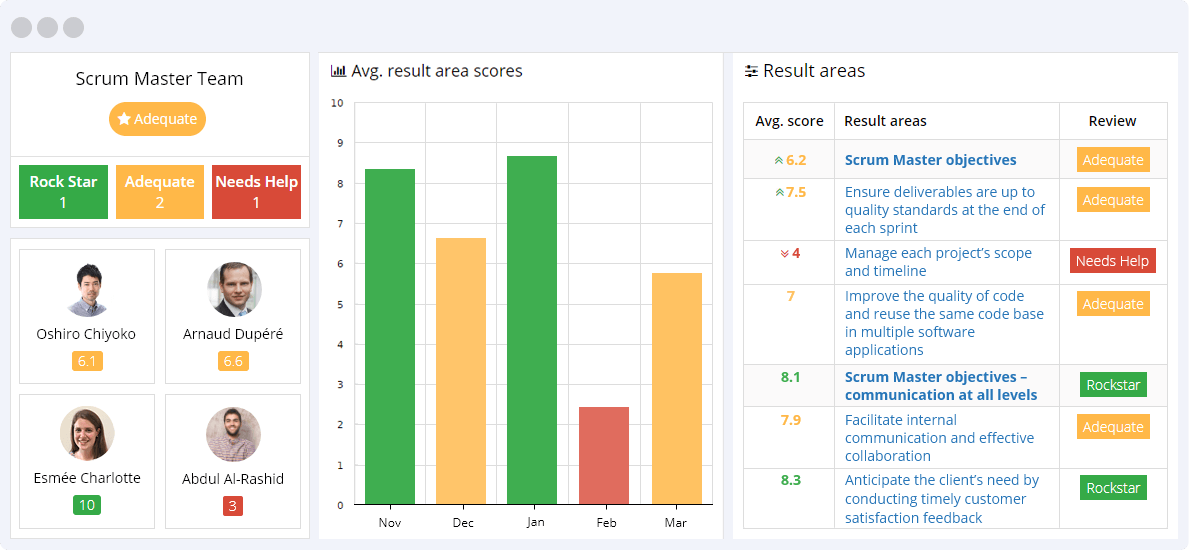Scrum Master Objectives – Helping Software Development Teams Apply the Scrum Framework
The Scrum Master objectives or KPIs that include helping software development teams apply the Scrum framework are designed to track and measure the scrum master’s ability to assist the software development team members in employing the Scrum framework to the software development process.
- Help the team agree on what they can achieve during each development sprint – This KPI tracks and measures the Scrum Master’s ability to help team members agree on what they can achieve during each development sprint. The higher this metric, the greater the extent to which the Scrum Master can assist team members in agreeing on each development sprint’s scope.
- Help teams implement changes effectively – This KPI tracks and measures the extent to which the Scrum Master helps teams implement necessary changes effectively. The higher this metric, the greater the Scrum Master’s ability to assist teams in executing changes efficiently.
View all
- Mentoring team members when implementing Agile frameworks – Agile is an overarching philosophy for software development, and an agile framework is a specific software-development approach based on the Agile philosophy. This KPI tracks and measures the extent to which the Scrum Master is able to mentor team members when implementing an Agile framework.
- Resolve conflicts and remove obstacles that occur – This KPI tracks and measures the Scrum Master’s ability to resolve conflicts and remove obstacles to ensure that the software development process proceeds smoothly based on the Agile philosophy and framework. The higher this metric, the greater the extent to which the Scrum Master can resolve conflicts and remove obstacles.
View less
Scrum Master Objectives – Planning Deliverables, Helping Teams & Monitor Performance
The Scrum Master objectives or KPIs that assess the scrum master’s ability to plan deliverables, help teams, and monitor performance are designed to measure the extent to which the Scrum Master fulfills this role. The higher these metrics, the greater the chance of both the Scrum Master’s and teams’ successes.
- Ensure deliverables are up to quality standards at the end of each sprint – Software development deliverables based on the Agile framework must match minimum quality standards by the time the end of a sprint is reached. This KPI tracks and measures the Scrum Master’s ability to ensure that deliverables are up to quality standards at the end of each sprint.
- Manage each project’s scope and timeline – Part of the Scrum Master’s role is to manage each software development project’s scope and timeline to ensure that the project brief remains within the scope and the completion timeline is adhered to. This KPI tracks and measures the Scrum Master’s ability to manage a project’s scope and timeline.
View all
- Reduce software bugs found by the internal testing team – The Scrum Master must manage the process of reducing software bugs found by the internal testing team. Existing software bugs be fixed, and the dev team must implement measures to prevent bugs from reoccurring. This KPI tracks the Scrum Master’s ability to manage the software bug reduction process.
- Improve the quality of code and reuse the same code base in multiple software applications – Code quality and the reuse of the same code in multiple software applications are vital to the successful software development lifecycle. The Scrum Master must manage this process by implementing an Agile framework to improve the quality of code and reuse the same code base in numerous software applications.
View less
Scrum Master Objectives – Communication at All Levels
The Scrum Master objectives or KPIs that assess the communication at all levels are designed to track and measure the Scrum Master’s ability to facilitate communication across all levels, between individual team members and between teams and management, including deploying unit testing and ensuring that product backlog items are transparent.
- Deploy unit testing for all components, improve test cases and product quality – The Scrum Master must deploy unit testing for all components, improve test cases, and the quality of the software developed. This KPI measures the extent to which the Scrum Master deploys unit testing, improves test cases, and ultimately the overall quality of the software applications developed by the dev teams.
- Ensure that the product backlog items are transparent and clearly expressed – Ensuring that the product (software) backlog items are transparent and clearly expressed is an integral part of the Scrum Master’s role. This KPI tracks and measures the extent to which the Scrum Master is able to make sure that all backlog items are understandable and transparently communicated.
View all
- Ensure that all role players hold the same understanding of the product backlog items – All role players must agree with the existing product backlog items. This KPI tracks and measures the Scrum Master’s ability to ensure that all role players have the same perception of the current software backlog items; otherwise, the software development project will be delayed and increase in scope.
- Facilitate internal communication and effective collaboration – The Scrum Master must facilitate internal communication and effective collaboration between individual team members and team members and management. This KPI tracks and measures the Scrum Master’s ability to foster internal dialogue and practical cooperation between individual team members and management.
- Anticipate the client’s need by conducting timely customer satisfaction feedback – Customer satisfaction reviews are a useful tool designed to measure customer satisfaction levels. This KPI tracks and measures the extent to which the Scrum Master is able to anticipate the client’s need by conducting timeous customer satisfaction feedback surveys that ask the right questions.
View less
Scrum Master Objectives – Managing Sprints, Retrospective Meetings, and Daily Stand-Ups
The Scrum Master objectives or KPIs that assess managing sprints, retrospective meetings, and daily stand-ups are designed to track and measure the Scrum Master’s ability to organize meetings, sprints, and daily stand-ups. These metrics include conducting stand-up scrum meetings and defining clear roles and responsibilities for team members.
- Conduct well-timed stand-up meetings – A core function of the Scrum Master’s role is to conduct well-timed stand-up meetings. This KPI measures the extent to which the Scrum Master is able to convene stand-up meetings at the right time. The higher this metric, the more successful the Scrum Master is at holding stand-up meetings.
- Define clear roles and responsibilities to improve accountability – The Scrum Master’s role includes defining clear roles and responsibilities for team members to improve individual and team accountability. This KPI tracks and measures the Scrum Master’s ability to define clear roles and responsibilities to strengthen accountability metrics.
View all
- Ensure deliverables are up to the required quality standards at the end of each sprint – This KPI measures the Scrum Master’s ability to ensure that project deliverable are up to the required quality standards at the end of each sprint. The higher this metric, the greater the extent to which the Scrum Master ensures that deliverables meet the standard of quality needed.
- Providing the team with a list of items that need improvement – The Scrum Master’s role includes providing the team with a list of items that need improvement. This KPI tracks and measures the extent to which the Scrum Master is able to draw up and supply the software dev team with a list of items that need improvement.
View less
Scrum Master Objectives – Managing Product Backlog
The Scrum Master objectives or KPIs that asses managing product backlog are designed to measure the extent to which the Scrum Master manages the product backlog by working with product owners to handle backlogs and new requests, acts as the primary liaison between team and client, and manages velocity consistency.
- Work with product owners to handle backlogs and new requests – The Scrum Master must be able to work with product owners to handle software development product backlogs and new requests. This KPI tracks and measures the extent to which the Scrum Master works with product owners concerning product backlogs and new proposals.
- Act as a primary liaison between team and client – The Scrum Master must act as a primary liaison between the software development team and the client to ensure that a quality product is delivered within the project deadlines and scope. This KPI tracks and measures the Scrum Master’s ability to liaise between the dev team and the client.
View all
- Manage velocity consistency – Scrum velocity optimization is an integral part of the Scrum Master’s Role. Sluggish velocity shows that employee performance has drastically decreased, and intervention is needed to improve software development momentum. This KPI measures the Scrum Master’s ability to manage velocity consistency successfully.
View less
These KPIs provide the foundation upon which to measure the Scrum Master’s core role efficiencies. They are critical reference points used to monitor the Scrum Master’s month-on-month performance, ensuring consistency and reliability during the software development lifecycle, facilitating a successful software development project within scope, deadlines, and budget.
The Scrum Master KPIs are divided into five result areas: Helping software development teams apply the Scrum framework, planning deliverables, helping teams & monitor performance, ensuring communication across all levels, managing sprints, retrospective meetings, and daily stand-ups, and managing the product backlog. These result areas are designed to track and measure the five critical areas of the Scrum Master’s role in implementing the Agile software development methodology.
The Scrum Master’s successes form an indispensable part of the successful software development lifecycle, driving the development of a software application within the project scope and deadlines; thereby, enhancing the company’s ability to meet its strategic goals and ensuring sustainable growth over time.

